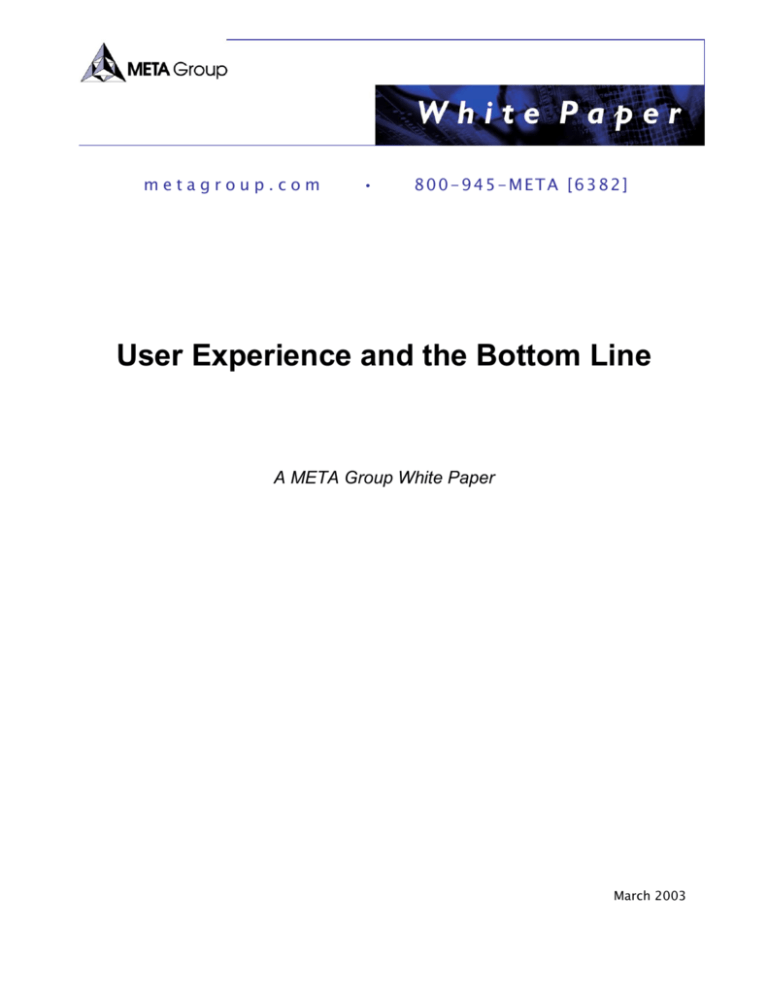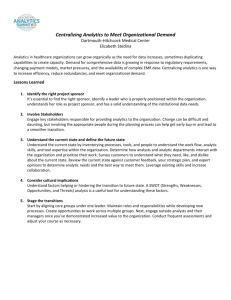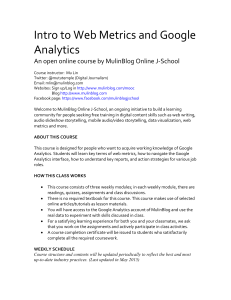
metagroup.com
•
800-945-META [6382]
User Experience and the Bottom Line
A META Group White Paper
March 2003
User Experience and the Bottom Line
Contents
Executive Summary ............................................................................................. 2
The Emergence of the Web Site as a Customer Channel ................................. 4
Commerce ..................................................................................................................................... 5
Community (e.g., Relationship Building) ....................................................................................... 5
Information..................................................................................................................................... 6
Service........................................................................................................................................... 6
Bottom Line.................................................................................................................................... 7
Defining a Quality-of-Experience Measurement Framework............................ 8
Clickstream Analytics .................................................................................................................... 8
Performance and Reliability........................................................................................................... 9
Usability Analysis........................................................................................................................... 9
Web-Based Surveys .................................................................................................................... 10
Audience Panels.......................................................................................................................... 10
Bottom Line.................................................................................................................................. 10
Structuring Organizational Roles to Execute .................................................. 11
The Web Team ............................................................................................................................ 12
Infrastructure and Operations...................................................................................................... 12
Enterprise Analytics ..................................................................................................................... 12
Business Process Owners........................................................................................................... 13
Bottom Line.................................................................................................................................. 14
Measuring the Return on Investment From a Positive User Experience....... 15
Bottom Line.................................................................................................................................. 16
Conclusion: User Recommendations .............................................................. 17
208 Harbor Drive • Stamford, CT 06912-0061 • (203) 973-6700 • Fax (203) 359-8066 • metagroup.com
Copyright © 2003 META Group, Inc. All rights reserved.
1
User Experience and the Bottom Line
User Experience and the Bottom Line
Content & Collaboration Strategies, Enterprise Analytics Strategies
Kurt Schlegel, Jennifer Vollmer
Executive Summary
To date, de facto metrics to assess Web site value are related to “eyeball” volume
(e.g., unique sessions, duration of session), but this rarely reflects the true benefit
of a Global 2000 (G2000) Web site or Web page, because advertising revenue is
not the site’s primary goal. For most G2000 companies, value is found in the sellside commerce, self-service, lead-generation, community-building, or
informational aspects of the site. Indeed, Web site spending by G2000 enterprises
closely parallels the recent dynamics of the dot-com market — dot-com
companies without a valid business model collapsed; similarly, G2000 Web sites
without an identifiable benefit (e.g., contribution to sales, marketing, or customer
service) will also fail. These wasted Web investments not only reduce corporate
earnings (attacking the bottom line), but also discourage additional Web
investments that could increase business opportunities (attacking the top line).
As a result, business-oriented metrics or key performance indicators (KPIs)
gauging the efficacy of a Web site as a customer channel have emerged in some
organizations. These metrics will be segmented according to specific business
objectives (customer service, sales, operations) that, in turn, drive Web page
functionality (e.g., content-driven, application delivery). Moreover, these metrics
identify how well organizations package people and process around Web
technology to create a real customer channel. A derivative and potentially
detrimental impact of business-based KPI adoption will be felt in the Web
development team, with future Web site redesigns being engineered specifically to
demonstrate improved measurement over time — potentially at the expense of
less tangible or quantifiable Web site improvements. In particular, attitudinal
metrics about a user’s overall satisfaction must be combined with easier-to-define
metrics (e.g., performance, reliability, clickstream analysis) to gain a
comprehensive indication of a user’s overall quality of experience (QoE).
This report will explain how to create a QoE measurement framework, including a
definition of the three major KPI categories: 1) Web site performance and
reliability; 2) usage and clickstream analysis; and 3) usability. Once the metrics
have been defined, systems management and analytic tools must be put in place
to collect the necessary data and continually report these metrics to the
208 Harbor Drive • Stamford, CT 06912-0061 • (203) 973-6700 • Fax (203) 359-8066 • metagroup.com
Copyright © 2003 META Group, Inc. All rights reserved.
2
User Experience and the Bottom Line
appropriate constituency. Furthermore, organizational roles and responsibilities
must be defined and mapped to operational tasks. Finally, this report will identify
clear business benefits derived from measuring QoE metrics extensively. Note
that, because the focus of this paper is QoE measurement, it will not discuss
solutions that directly improve QoE (e.g., e-service for usability, server clustering
for performance).
208 Harbor Drive • Stamford, CT 06912-0061 • (203) 973-6700 • Fax (203) 359-8066 • metagroup.com
Copyright © 2003 META Group, Inc. All rights reserved.
3
User Experience and the Bottom Line
The Emergence of the Web Site as a Customer Channel
It took a dot-com implosion, but the role of a Web site as a customer channel that
is complementary to other channels (e.g., direct sales, call center, resellers) has
been clearly defined for most Global 2000 organizations. Customer relationship
management (CRM) programs implemented in the last two years have
categorized customer life-cycle activities around four primary phases: engage
(e.g., marketing), transact (e.g., commerce), fulfill (delivery of product), and
service (e.g., post-sale support). Organizations can then analyze customer
relationships in terms of “ETFS” patterns that illustrate how customers interact
with companies in terms of channels and points of interaction (e.g., Web sites). In
the course of this life cycle, a customer will transition (hopefully without
restrictions) across different channels. For example, a product purchased on a
Web site can usually be returned at a “brick and mortar” retail store. An e-mail
marketing campaign that drives prospects to a Web site displaying promotional
information can bolster sales leads for a direct sales force.
This cross-channel customer life-cycle model creates dramatic synergies capable
of optimizing business results. For most Global 2000 organizations, online
channels such as the Web and e-mail are significantly cheaper than offline
channels. Certain customer segments might also prefer electronic channels to the
telephone or physical stores. As a result, business processes can be restructured
to manage at least part of the customer life-cycle — typically engage and service
— through more effective online alternatives. For example, servicing a client
inquiry through an automated Web site with natural language query recognition
diverts that query away from a more expensive call center. The cross-channel
customer life-cycle model also facilitates the routing of more important
transactions or customers to optimized resources (e.g., a service representative
might offer a co-browsing session to a repeat, high-value customer).
Now that the Web site has assumed its role alongside the other more venerable
customer channels, Global 2000 organizations must ensure that the Web site is
engineered to deliver the best possible experience for each customer. Without this
quality of experience, the Web site can damage the overall brand image of the
company. The days of a Web site being a separate dot-com entity are over, both
on the balance sheet and in the perceptions of customers. As a result,
organizations must clearly define the purpose of the Web site and its role in
fulfilling the customer life cycle.
208 Harbor Drive • Stamford, CT 06912-0061 • (203) 973-6700 • Fax (203) 359-8066 • metagroup.com
Copyright © 2003 META Group, Inc. All rights reserved.
4
User Experience and the Bottom Line
Most Web sites can be broken into the following business models: commerce,
community (e.g., customer-to-customer interactions), information (e.g., publish,
speed sales cycle, generate leads), and service (e.g., self-service, customer
support). This categorization is necessary because different business models will
require different measures of success. Below, we expand on the four different
types of sites and the user behavior the site is trying to induce.
Commerce
A commerce site is designed to enable prospects and customers to execute a
transaction (e.g., purchase a product or service) and must be tied to analytics that
will help business stakeholders understand the reasons behind Web site
abandonment. Examples of commerce sites are gap.com and eddiebauer.com,
whose sites are designed to replicate and enhance the real-world shopping
experience by offering customers a personalized environment. One META Group
client that tied performance and usability metrics to Web site ROI was able to
achieve a 10% reduction in shopping cart abandonment, leading to a 17%
revenue increase. Other success measures include:
•
Greater consumption of products/services (deeper penetration)
ס
Higher up-sell/cross-sell rates (broader penetration)
ס
Reduction in customer abandonment
•
Revenue measures
ס
Uplift per transaction
ס
Increased transaction frequency
ס
ROI/NPV metrics
•
Better customer efficiency/pricing
ס
Offers targeted to individual needs (potentially more dynamic pricing
at the point of sale)
•
Increased customer acquisition
ס
Higher conversion ratios
ס
Less elapsed time (prospect to client)
Community (e.g., Relationship Building)
A community Web site addresses the need for intimacy between the organization
and its customers, or among customers themselves. This type of site is trying to
generate interest in the company or product, build closer relationships, and
promote further customer “team building” and collaborative interaction.
Community-focused Web sites like Charles Schwab’s offer prospective customers
incentives to become members. These can include topic-oriented threaded
discussions that offer the prospective customer an opportunity to become more
deeply involved with the company or product. Although also considered commerce
sites, Amazon and eBay are good examples of community sites because they
208 Harbor Drive • Stamford, CT 06912-0061 • (203) 973-6700 • Fax (203) 359-8066 • metagroup.com
Copyright © 2003 META Group, Inc. All rights reserved.
5
User Experience and the Bottom Line
enable customers to share opinions on products and to communicate with each
other. Measuring the effectiveness of a community Web site is different from
measuring a commerce site, because user experience is subjective and requires
anecdotal feedback from users tied to empirical success measures (e.g., how may
people come to a specific brand section, participate, and come back), as well as a
measurement of the amount of collaboration that is done (e.g., how many people
post things, whether it is read and valued). Other success measures include:
•
Improved customer or employee knowledge/learning
•
Greater customer reach
•
Number of community members (registration metrics)
•
Retention and churn rates of community members
•
Actions of community members (to surveys and offers) versus noncommunity members
Information
An informational Web site is designed to enable users to gather basic information
about a company’s history, mission, philosophy, products, services, and job
opportunities. This is increasingly accomplished via dynamic/personalized
information aimed at a particular user segment identified via clickstream
information and customer self-identification. The focus is to promote the
organization and products, reduce the sales cycle, and generate leads while
leaving the transaction to other sales channels. Success measures of an
informational site include:
•
Increased customer retention
o Greater loyalty/satisfaction
o Increased effectiveness/more utilization of site resources
•
Better customer efficiency
o More productive time on the site (tasks are streamlined)
•
Lead generation
•
Reduced sales cycle
Service
A service Web site is focused on customer-initiated interactions by delivering
customer support requests to an automated resource that answers inquiries
without (or with less) human intervention. It typically requires alignment between
Web teams and the customer support organization. Moving customer queries
away from offline resources (i.e., the call center) enabled a META Group client to
show a 15% cost savings. In its simplest form, a frequently asked questions (FAQ)
page could be considered e-service, but most G2000 organizations are looking for
more elaborate capabilities. We expect strong adoption of natural language query
mechanisms that use artificial intelligence or linguistic techniques to understand
208 Harbor Drive • Stamford, CT 06912-0061 • (203) 973-6700 • Fax (203) 359-8066 • metagroup.com
Copyright © 2003 META Group, Inc. All rights reserved.
6
User Experience and the Bottom Line
the user’s question and provide some type of useful answer (perhaps in concert
with FAQs and other navigational aids). To measure the success of a serviceoriented Web site, companies should consider:
•
Improved customer knowledge/learning and satisfaction
o Increased effectiveness/more utilization of site resources
•
Better customer efficiency
•
More productive time on the site (tasks are streamlined)
•
Reduced customer support costs or improved use of customer service
resources
Bottom Line
The Web site has assumed a complementary role, instead of a cannibalistic one,
as a customer channel. Global 2000 organizations are clearly defining the scope
and purpose of Web sites around four primary categories: commerce, community,
information, and service.
208 Harbor Drive • Stamford, CT 06912-0061 • (203) 973-6700 • Fax (203) 359-8066 • metagroup.com
Copyright © 2003 META Group, Inc. All rights reserved.
7
User Experience and the Bottom Line
Defining a Quality-of-Experience Measurement
Framework
Customers’ impressions of a Web site are influenced by many factors — user
interface design, management of user interactions, navigational structures,
trustworthiness (e.g., privacy/security), and factors associated with doing business
via the site itself (service and fulfillment). During the next few years, establishing
metrics and key performance indicators around customer QoE will require an
analytical framework that includes multiple assessment techniques (e.g., audience
measurement, surveys, performance/use analytics). Most current QoE measures
are response-time-focused. Although valuable, critical business decisions
concerning site investments in functionality, infrastructure, and operations should
take into account real customers’ perceptions and attitudes.
During 2003/04, organizations should invest in business intelligence (BI)
frameworks (spanning process, technology, and staff) to provide customer-centric
guidance to infrastructure and operational investments. Innovative organizations
will exploit these activities by integrating QoE measures into strategic e-business
initiatives (e.g., e-commerce, CRM). Companies failing to capitalize on business
intelligence frameworks risk reduced ROI from misdirected investments and
marginalized brand perceptions by customers.
The hybrid nature of QoE efforts compels organizations to understand market
segmentation and its related impact on selection criteria. Although there are many
components to a QoE measurement framework (see Figure 1), most of the tools
fall within three primary categories: clickstream analytics, performance and
reliability, and usability.
Clickstream Analytics
Clickstream analysis evaluates user sessions, interactions, and the sequence of
pages visited. These tools transform Web site usage information into more explicit
information about users’ sessions, such as what they buy and what pages they
visit on the site. The tools also establish a baseline around online usage
behaviors. The clickstream analysis space is very fragmented, and solutions in
this area represent only one part of a broader customer intelligence analytic
system. Web analytics specialists such as NetIQ/WebTrends, WebSideStory, and
Coremetrics dominate the clickstream analysis space. However, Web analytic
functionality from traditional BI organizations (e.g., SAS, Informatica, SPSS), CRM
(e.g., E.piphany), and portal vendors (e.g., IBM, Vignette) is being used to
measure Web site performance. In particular, the QoE value of clickstream
208 Harbor Drive • Stamford, CT 06912-0061 • (203) 973-6700 • Fax (203) 359-8066 • metagroup.com
Copyright © 2003 META Group, Inc. All rights reserved.
8
User Experience and the Bottom Line
analytics is in “sessionizing” user interactions into more meaningful metrics. The
primary application of clickstream analysis for QoE measurement is to report
metrics such as abandoned transactions and identify problematic path sequences.
Figure 1 — Quality-of-Experience Measurement
Framework Components
Panels
Surveys
Usability
Analysis
Tools
Clickstream Analysis
Performance Analytics
Performance and Reliability
Most performance monitoring products are thought of in two ways: 1) measures of
the underlying response time of the IT systems; and 2) measures via a user view
of how well certain activities can be performed. Performance monitoring is one of
the most mature QoE components and is currently used by more than 75% of
G2000 companies. Performance analysis tools such as Keynote, BMC, and
Mercury can track the reliability of a Web site, enabling organizations to gain
trouble-shooting capabilities. Performance monitoring is most effective in
gathering real data on competitors’ response time for benchmarking purposes. We
believe correlating clickstream and performance is paramount to establishing a
quality-of-service baseline.
Usability Analysis
Usability analysis products measure a Web site via a user view of how well certain
activities can be completed beyond mere response time and performance. These
services include certain assumptions regarding Web site ergonomics when
assessing site structures (e.g., navigation). Using software to simulate browsing
208 Harbor Drive • Stamford, CT 06912-0061 • (203) 973-6700 • Fax (203) 359-8066 • metagroup.com
Copyright © 2003 META Group, Inc. All rights reserved.
9
User Experience and the Bottom Line
behavior or technology that enables manual tracking, simulation vendors such as
WebCriteria and Decise determine if end users are utilizing a site effectively,
ensuring the effectiveness of overall site design, and giving feedback as to what
aspects are ineffective. Keynote’s WebEffective performs similar tasks by
sampling real users. There are two primary subsets of usability analysis: surveys
and panels.
Web-Based Surveys
Online survey companies (e.g., Inquisite, MarketTools, Keynote, Survey.com,
Satmetrix) enable organizations to ask directly for information and opinions. Many
vendors, such as Perseus and Scantron, offer valuable back-end consulting to
design surveys, interpret results, and plan future corporate strategy based on
results. We expect that many e-survey vendors will be acquired by operational
and analytical CRM vendors (e.g., Siebel, E.piphany, Broadbase). Traditional
large-scale survey vendors (e.g., Harris Black, Greenfield, Gallup) interested in
offering a complete evaluation of customers will also diversify via more targeted
performance-based surveys.
Audience Panels
Panel vendors (e.g., Vividence, ComScore NetValue, Gomez, NetRatings) gauge
Internet behavior, activity, and opinions. However, we believe it is difficult to obtain
granularity with such tools. They can look at broad sites and track Web activity,
behavior, and opinions on the sites to which their panel members go. Panels are
most successful in monitoring top-100 Web sites, but many brick-and-mortar sites
fall below their radar screens (e.g., with more specific or granular Web sites, it
becomes difficult to have a sample size broad enough to draw any large
conclusions). Large organizations investing in strategic marketing initiatives will
find panels useful in uncovering industry trends and gathering real-time feedback
from target customers. During the next two years, META Group contends online
survey and panel organizations will increasingly become integrated.
Bottom Line
In developing a quality-of-experience business strategy, organizations need a
strong analytical platform and must design analytics into the Web site as part of
their design efforts. Although there is no single-vendor solution, IT departments
can custom-blend solutions to configure with this strategy.
208 Harbor Drive • Stamford, CT 06912-0061 • (203) 973-6700 • Fax (203) 359-8066 • metagroup.com
Copyright © 2003 META Group, Inc. All rights reserved.
10
User Experience and the Bottom Line
Structuring Organizational Roles to Execute
Three organizational groups that exist in most Global 2000 organizations map
directly to the three categories of the QoE measurement framework defined earlier
in this paper. The server and network infrastructure group has ultimate authority to
maintain service levels relating to a Web site’s performance and reliability. The
enterprise analytics group, often referred to as the “data warehouse team,” should
be responsible for collecting and reporting clickstream data. Finally, the Web team
that controls all site production activities should be in charge of collecting Web site
usability feedback from customers. Our research indicates two of these
organizational groups — the infrastructure and the Web team — are appropriately
tasked with performance/reliability and usability measurement, respectively.
However, the analytics team in most G2000 organizations is not in charge of
clickstream data collection. Instead, this task is performed, often reluctantly, by the
Web team. To help repair this situation, we will outline how organizations should
reorganize their clickstream analysis responsibilities.
Our research indicates the enterprise analytics team is significantly involved in just
20% of Web analytics projects. Most Global 2000 organizations rely primarily on
the Web team and marketing departments for collecting requirements, evaluating
vendors, and implementing a solution. This arrangement was tenable during the
era of data marts and stovepiped analytics, but enterprise analytics teams
responsible for running the data warehouse must play a larger role, if not the lead,
in managing Web analytics initiatives.
While we acknowledge the difficulties of creating and maintaining an enterprise
data model, the broader role of the enterprise analytics team better enables
correlation of Web data with other customer channels (e.g., call center, sales) and
business processes. Moreover, marketing departments have saddled reluctant
Web teams with the technical responsibility of analyzing Web site activity. This
reluctance is one reason Web analytics outsourcers, which minimize the role of IT,
have been increasingly selected over labor-intensive software solutions. Although
we expect outsourced service providers to continue as the preferred solution,
enterprise analytics teams will increasingly lead Web analytics project during the
next 12-24 months. During the next five years, efforts to create a customer
information master file will culminate in a broader analysis of the Web site’s role in
a multi-channel strategy. By 2007, 80% of Web analytics projects will be managed
centrally by the enterprise analytics team, as part of the data warehouse.
208 Harbor Drive • Stamford, CT 06912-0061 • (203) 973-6700 • Fax (203) 359-8066 • metagroup.com
Copyright © 2003 META Group, Inc. All rights reserved.
11
User Experience and the Bottom Line
The Web Team
The Web team’s role in managing the Web analytics initiative is analogous to the
role an SAP project team plays for ERP analytics (e.g., technical advice,
instrumentation). With the increasing popularity of page beacons as a data
collection technique, the Web team will need to coordinate JavaScript tags with
Web content management platforms. In particular, custom variables created to
optimize Web analytics must be rendered through dynamic pages. In addition,
overall Web site design and usability remain a primary task of the Web team, so in
this case, the Web team becomes more of a user of Web analytics reports than a
provider of them.
We expect customer feedback mechanisms (e.g., Informative, Enviz, Vividence) to
be used increasingly to collect performance metrics on Web site usability.
Furthermore, analytics in general will be tied to portal framework initiatives, where
each portal user receives real-time updates of key performance indicators (KPIs)
predefined for a given community. The Web team will be responsible to ensure
this data is integrated into the B2E, B2B, and B2C portal frameworks. Finally, the
Web team must oversee the collection of personally identifiable information (PII)
from the Web site and ensure PII data collection complies with corporate privacy
policies.
Infrastructure and Operations
In the early days of the Internet, separate infrastructure teams were created to
support Internet infrastructure. Our research indicates these redundant teams
have been consolidated into central infrastructure and operations groups. It is this
central team that must create service levels and track performance and reliability
metrics with respect to Web sites and all online services (e.g., e-mail). The
infrastructure and operations team must work with both the Web team and
business owners of the Web site (e.g., sales, marketing, customer support) to
ensure insight derived from performance and reliability measurements is used to
make channel decisions. We believe most G2000 organizations are doing a
reasonable job at that task, but QoE measurements are still limited by one
technical fact. There are virtually no reports provided in most G2000 shops that
directly correlate performance with behavioral success on the Web site (e.g.,
online transaction). It would be useful to show the impact that performance and
reliability have on the efficacy of a Web site, but unfortunately, technical limitations
often prevent this correlation.
Enterprise Analytics
The major barrier inhibiting a holistic approach to business performance
management (BPM) is the difficulty of technology integration across stovepiped
208 Harbor Drive • Stamford, CT 06912-0061 • (203) 973-6700 • Fax (203) 359-8066 • metagroup.com
Copyright © 2003 META Group, Inc. All rights reserved.
12
User Experience and the Bottom Line
data sources. To overcome these barriers, most organizations focus on data
integration of ERP, CRM, and SCM deployments, but the integration must also
occur across personnel (i.e., organizational constituents). The role of the
integrator should be played by the enterprise analytics team because this group is
best positioned to solicit requirements, build data models, design reports, and
integrate data across all data warehouse initiatives and business process owners.
Incorporating Web analytics will be a challenge because virtually all Web channel
statistics facilities use proprietary data models and business intelligence tools.
Nevertheless, there are examples from some verticals (e.g., retail, telecom) where
strong enterprise analytics teams have had success integrating Web analytics with
other parts of the business.
For 10 years, enterprise analytics teams within IT have serviced business
intelligence requirements for a cross-section of business process owners. Pushing
Web analytics under the enterprise analytics umbrella will leverage these
collaborative relationships for the ultimate benefit of the company. Thus, a central
analytics group will consult with business process stakeholders about
“actionability” of the data. Through this consultation, the enterprise analytics team
will develop KPI measurements with a top-down tiered approach, then measure
the business process to collect benchmarks. The increasing use of Web sites to
automate various business processes only strengthens the argument to build
these KPIs into a Web analytics solution.
Business Process Owners
The business performance management (BPM) life-cycle process includes setting
a metric, measuring performance with that metric, and developing actionable
business plans to guide future performance. The dominance of the Web analytics
domain by marketing groups is evident because most reports and, consequently,
BPM metrics are marketing-focused (e.g., cross/up-sell, lead generation). The
marketing department should still play a major role, but organizations must realize
that it is just one user group of a larger Web (and enterprise) analytics initiative. All
business process stakeholders (e.g., sales, customer service, product managers,
resellers) must participate by generating requirements and interacting with reports.
For example, auto manufacturers use the “car configurator” on their Web sites as
an indicator of customer preference for car designs. Marketing has been able to
feed this information to influence production schedules, but only recently have car
dealers been given access to this information (or had it broken down by dealer
geography). Now these dealers have better insight into which options to order
(e.g., how many SUVs with a third seat). This example demonstrates how
breaking down technical restrictions improved some collaboration regarding
analytics, but it was not until the organizational restrictions were eliminated that
208 Harbor Drive • Stamford, CT 06912-0061 • (203) 973-6700 • Fax (203) 359-8066 • metagroup.com
Copyright © 2003 META Group, Inc. All rights reserved.
13
User Experience and the Bottom Line
the benefit of this insight was fully realized (i.e., all business process owners were
able to use the data).
Bottom Line
Organizational teams should be restructured with a broader role for enterprise
analytics teams — to minimize the parochial view of Web activity and limited
insight that data mart architectures provide. The infrastructure group and Web
team should maintain control of measuring performance/reliability and usability
metrics, respectively.
208 Harbor Drive • Stamford, CT 06912-0061 • (203) 973-6700 • Fax (203) 359-8066 • metagroup.com
Copyright © 2003 META Group, Inc. All rights reserved.
14
User Experience and the Bottom Line
Measuring the Return on Investment From a Positive
User Experience
By 2004, 75% of Global 2000 enterprises will have consistent Web site benefit
metrics that are tracked regularly to show improvement over time. Metrics related
to Web site performance (e.g., page view response time) and Web site design
(e.g., number of clicks to accomplish a task) will be virtually universal across
G2000 enterprise accounts. We have explained QoE as an amalgam of different
Web diagnostic tools tied to process and measurements, which tie metrics to user
behavior. Although metrics may vary, general categories related to customer
loyalty, reduced sales cycle, self-service, etc. will map to Web site behavior types:
content (information-focused), self-service (community-focused), application
(commerce-focused), and collaborative (service-focused). Once the general
category is identified, the specific formula to calculate the value of the metric must
be determined by the enterprise. For example, metrics for commerce
effectiveness must be linked to the execution of some customer-oriented target
(e.g., this would be community, purchased merchandise, attending a product
seminar) achieved after that customer viewed a particular Web page, but
determining which customer target to choose depends on specific business
processes. It is important to recognize the metrics designed to assess the
business benefit of a Web site are unique to the goals and processes of that
particular enterprise. Typically, a plethora of metrics will be adopted, but a
manageable number (<5-10) should be used to manage any one user’s behavior
group (e.g., commerce, information, community, service).
Because the cost for Web site deployments and ongoing (i.e., multiyear)
operations can easily surpass $10 million, Web site business justification has
become a top concern for G2000 organizations. Most predeployment justifications
use pro-forma estimates of productivity improvements, cost savings, and
increased revenue opportunities, but once the project is approved, these
estimates are frequently disregarded. Instead our research indicates the business
case for Web sites relies on the post-deployment collection of data to feed specific
metrics that communicate the Web site’s quality of experience and overall value.
Tracking these metrics with an ongoing systemic process will be critical to
ensuring the success of a Web site.
208 Harbor Drive • Stamford, CT 06912-0061 • (203) 973-6700 • Fax (203) 359-8066 • metagroup.com
Copyright © 2003 META Group, Inc. All rights reserved.
15
User Experience and the Bottom Line
Figure 2 provides a simple calculation for an e-commerce site. Although the lost
revenue opportunities resulting from a poor QoE for a commerce-oriented site are
readily apparent, we believe QoE degradation dramatically impacts content, lead
generation, and e-service-oriented sites as well. Often, poor usability leads users
to quickly terminate their session. These terminated sessions directly lead to
uninformed consumers, decreased lead generation, and unfulfilled service
requests. Beyond the Web, these terminated sessions also have damaging
impacts on the overall brand reputation of the organization.
Figure 2 — Maximizing the Return
t A 10% reduction in
shopping cart
abandonment leads
to a 17% revenue
increase
t Most organizations
don’t know why/if
users ended a
session, because
log files don’t
report it
Before
After
Improvement
50,000
50,000
-
% of Visitors Who Add to
Cart
5%
5%
-
# of Visitors Who Added
to Cart
2,500
2,500
-
% of Visitors Who
Abandon a Cart
40%
30%
10%
-25%
# of Buyers
1,500
1,750
250
17%
$60
$60
-
-
# of Visitors per Month
Average Value per
Order
Revenue per Month
Revenue per Year
% Change
$80,000
$105,000
$15,000
17%
$1,080,000
$1,260,000
$180,000
17%
Incremental Revenue for Each Point of Improvement
Per Month
$1,500
Per Quarter
$4,500
Per Year
$18,000
ROI calculations on non-commerce sites are
difficult to calculate, but just as important
Bottom Line
Fervent adoption of business-centric Web site metrics enables organizations to
assess Web site investments based on key performance indicators linked to
channel performance and contribution to sales, marketing, customer service, and
product objectives.
208 Harbor Drive • Stamford, CT 06912-0061 • (203) 973-6700 • Fax (203) 359-8066 • metagroup.com
Copyright © 2003 META Group, Inc. All rights reserved.
16
User Experience and the Bottom Line
Conclusion: User Recommendations
The Web channel is rarely responsible for all aspects of the customer life cycle.
However, most Global 2000 organizations have upgraded the strategic abilities of
their Web sites as primary customer channels to engage, transact, fulfill, and
service customers. In this role Web sites will complement other channels in a
hybrid-channel market strategy. As a result, the quality of experience (QoE)
encountered by Web site users directly impacts the organization’s brand image.
We believe G2000 organizations should implement a QoE measurement
framework across three categories: performance/reliability, usability, and
clickstream analysis. Organizational groups charged with monitoring these metrics
should be clearly identified to quickly identify lapses in QoE that jeopardize a
brand’s reputation.
Specifically, the server and network infrastructure team should monitor the Web
site’s performance and reliability, while the Web team should monitor usability
metrics (e.g., customer’s attitude about a Web site’s facility). Fortunately, most
G2000 organizations are already formalizing these responsibilities in both of these
groups. However, our research indicates that clickstream analysis metrics are
collected almost exclusively by the Web team. Although we do believe the Web
team should be closely involved with clickstream data collection and should use
the related reports to identify site design and layout issues, it is the enterprise
analytics group that is best suited to manage the clickstream analysis process. In
particular, the analytics team (often referred to as the “data warehouse team”)
already operates the infrastructure to handle massive data collection and has the
expertise to customize reports and handle complicated data management tasks.
The cost of diligently measuring QoE will provide a significant return by ensuring
Web sites are optimized to perform a particular task (e.g., commerce, lead
generation, e-service, information dissemination).
Kurt Schlegel is a program director with Enterprise Analytics Strategies at META
Group, Inc. Jennifer Vollmer is a research analyst with Content & Collaboration
Strategies at META Group, Inc. For additional information on this topic or other
METAmeasurement services, contact info@metagroup.com.
208 Harbor Drive • Stamford, CT 06912-0061 • (203) 973-6700 • Fax (203) 359-8066 • metagroup.com
Copyright © 2003 META Group, Inc. All rights reserved.
17
About META Group
Return On IntelligenceSM
META Group is a leading provider of information technology research, advisory services, and
strategic consulting. Delivering objective and actionable guidance, META Group’s experienced
analysts and consultants are trusted advisors to IT and business executives around the world. Our
unique collaborative models and dedicated customer service help clients be more efficient,
effective, and timely in their use of IT to achieve their business goals. Visit metagroup.com for
more details on our high-value approach.










